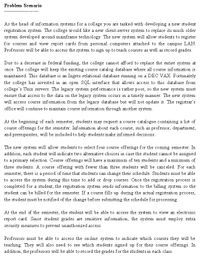
Q-1: Make A Class Diagram Of Given Scenerio.
As the head of
Due to a decrease in federal funding, the college cannot afford to replace the entire system at once. The college will keep the existing course catalog
At the beginning of each semester, students may request a course catalogue containing a list of course offerings for the semester. Information about each course, such as professor, department, and prerequisites, will be included to help students make informed decisions.
The new system will allow students to select four course offerings for the coming semester. In addition, each student will indicate two alternative choices in case the student cannot be assigned to a primary selection. Course offerings will have a maximum of ten students and a minimum of three students. A course offering with fewer than three students will be canceled. For each semester, there is a period of time that students can change their schedule. Students must be able to access the system during this time to add or drop courses. Once the registration process is completed for a student, the registration system sends information to the billing system so the student can be billed for the semester. If a course fills up during the actual registration process, the student must be notified of the change before submitting the schedule for processing.
At the end of the semester, the student will be able to access the system to view an electronic report card. Since student grades are sensitive information, the system must employ extra security measures to prevent unauthorized access.
Professors must be able to access the on-line system to indicate which courses they will be teaching. They will also need to see which students signed up for their course offerings. In addition, the professors will be able to record the grades for the students in each class.

Trending nowThis is a popular solution!
Step by stepSolved in 2 steps with 1 images

- identify an architectural pattern which can suit the operation of the hospital. You are expected to write about the identified architectural pattern in the context of the hospital information system.arrow_forwardWhy is it important to bring standalone systems into the Domain?arrow_forwardDescribe and draw use cases that an automated teller machine (ATM) provides to the bank customers. For the drawing part, you should draw the use case diagram on a paper and upload its photo.arrow_forward
- Write a research project on Implementing an M-Commerce Solution to Enhance Customer Experience in Retail Stores. The project should minimally contain the following sections: Table of contents Astract Business and Market Overview: This section must include an illustration Porter’s Model with the unique and specific pressures that the client faces. Problem Definition: Explain the current, or 'AS-IS', state process and illustrate it with a UML Activity Diagram with partitions that the customer leverages that could be improved with the use of technologies. Business Solution Proposal: taking the 'AS-IS' model from section 2, elaborate on how technology will be utilized to streamline or optimize the current process in order to solve the stated business problem. Explain the future, or ‘ 'TO-BE', state process and illustrate it with a UML Activity Diagram. Solution Assessment: Leverage the output from the previous three sections and quantify the value of the business solution. Identify and…arrow_forwardYou are part of a development team that is responsible for converting data from a legacy (already existing) system so that the data can be incorporated into a new Enterprise Resource Planning (ERP) system. During the process of examining the existing system and its data, you discover that several country location fields were mismanaged by the existing software, resulting in the company selling GMO (genetically modified organism) seeds not explicitly listed or labeled as being GMO in the affected countries. GMO seeds are completely unregulated in some countries, regulated and legal in others as long as they are labeled as GMO according to local regulations, and completely banned in yet others. Question:Based on the Software Engineering Code of Ethics and Professional Practice, how (in general terms) are you supposed to react? Cite at least four points/sub-points that apply to this situationarrow_forward
 Computer Networking: A Top-Down Approach (7th Edi...Computer EngineeringISBN:9780133594140Author:James Kurose, Keith RossPublisher:PEARSON
Computer Networking: A Top-Down Approach (7th Edi...Computer EngineeringISBN:9780133594140Author:James Kurose, Keith RossPublisher:PEARSON Computer Organization and Design MIPS Edition, Fi...Computer EngineeringISBN:9780124077263Author:David A. Patterson, John L. HennessyPublisher:Elsevier Science
Computer Organization and Design MIPS Edition, Fi...Computer EngineeringISBN:9780124077263Author:David A. Patterson, John L. HennessyPublisher:Elsevier Science Network+ Guide to Networks (MindTap Course List)Computer EngineeringISBN:9781337569330Author:Jill West, Tamara Dean, Jean AndrewsPublisher:Cengage Learning
Network+ Guide to Networks (MindTap Course List)Computer EngineeringISBN:9781337569330Author:Jill West, Tamara Dean, Jean AndrewsPublisher:Cengage Learning Concepts of Database ManagementComputer EngineeringISBN:9781337093422Author:Joy L. Starks, Philip J. Pratt, Mary Z. LastPublisher:Cengage Learning
Concepts of Database ManagementComputer EngineeringISBN:9781337093422Author:Joy L. Starks, Philip J. Pratt, Mary Z. LastPublisher:Cengage Learning Prelude to ProgrammingComputer EngineeringISBN:9780133750423Author:VENIT, StewartPublisher:Pearson Education
Prelude to ProgrammingComputer EngineeringISBN:9780133750423Author:VENIT, StewartPublisher:Pearson Education Sc Business Data Communications and Networking, T...Computer EngineeringISBN:9781119368830Author:FITZGERALDPublisher:WILEY
Sc Business Data Communications and Networking, T...Computer EngineeringISBN:9781119368830Author:FITZGERALDPublisher:WILEY





